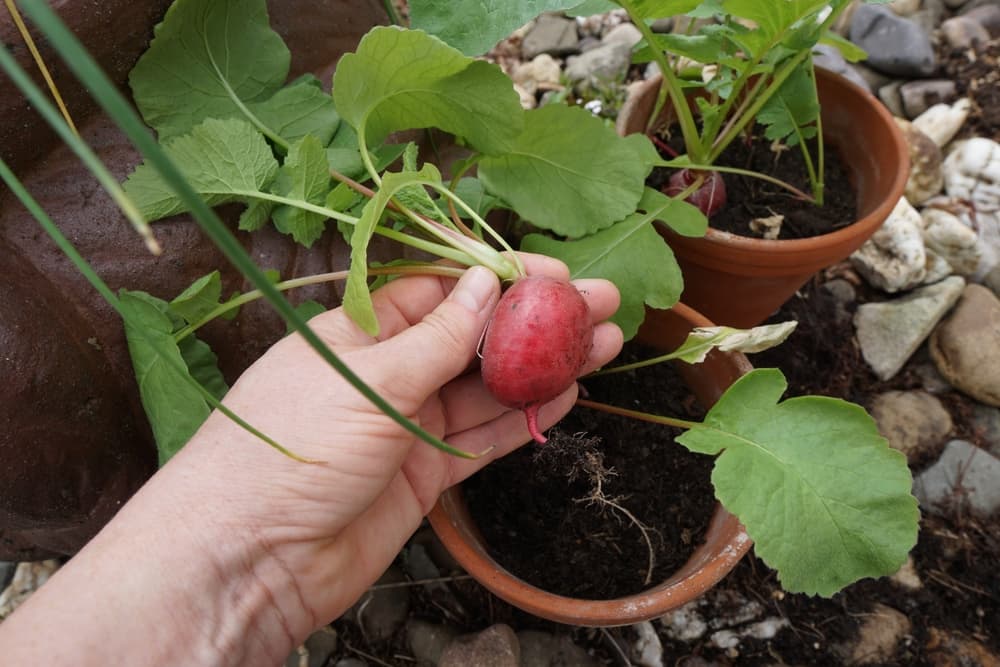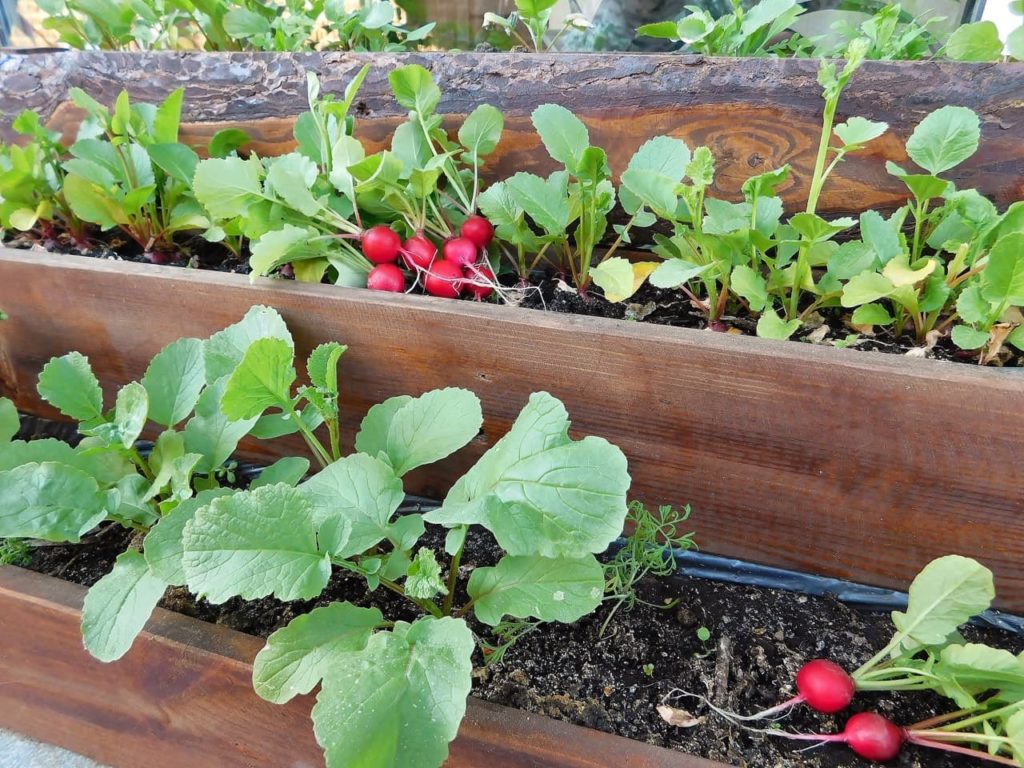8 Tips For Growing Radishes In Pots – ‘Avoid Crowding’ Says Gerald Stratford

VEGETABLES > RADISHES > CONTAINERS
Reviewed By COLIN SKELLY

Colin is a Horticulturist and Horticultural Consultant with experience in a range of practical and managerial roles across heritage, commercial and public horticulture. He holds the Royal Horticultural Society’s Master of Horticulture award and has a particular interest in horticultural ecology and naturalistic planting for habitat and climate resilience.
Contributions From GERALD STRATFORD

Gerald Stratford has been growing his own veg since the age of 4. He is the author of ‘Big Veg’ and is hailed as ‘The King Of Veg’ by his audience - with almost 500,000 keen followers across his various social accounts.
IN THIS GUIDE
RADISH GUIDES
Container Growing
Varieties
Summer radishes are wonderfully mild and flavourful with a succulent mouthfeel and are so easy to grow in pots.
On the other hand, if you like winter-grown radishes, some cultivars can be grown in containers too, but they might not be so easy to grow in this way.
Summer radishes are an excellent crunchy addition to light, cold summer salads, whilst zingy winter radishes are equally excellent in hearty pot-cooked foods.
Regardless of which kind of radish you grow, you can rest assured that it will taste twice as good coming from your garden, or from your pots, than from the supermarket.
| Difficulty | Easy |
| Equipment Required | Container, potting mix, radish seeds, watering can, fertiliser (optional) |
Are Radishes Suited To Container Growing?
Yes, in fact, it is quite easy to grow all varieties of summer radishes in pots and they are often grown in all kinds of containers, including grow bags for the smaller varieties.
It is also possible to grow some varieties of winter radishes in containers, though this is not commonly done.

If you are new to growing winter radishes in pots, I suggest you start with a variety that is not as large as most and does not take as much time to mature for harvest as most winter varieties do.
There is little point in attempting to grow a very large type, such as ‘Longipinnatus’, in a container.
1) Larger Planters Mean A Greater Yield
We suggest that you grow your radishes in a planter or tub rather than a pot.
Whatever container you use, it should have drainage holes.
The advantage of using a planter is that you can sow an entire row of radishes with confidence that they will have ample room and depth, which will result in a successful harvest.
If you use a standard 60cm planter, which is one of the smaller ones, you’ll be able to grow 16-20 summer radishes in a single row.
2) “Avoid Crowding” Says Gerald Stratford
Avoid squeezing them in too close because if you do, hot and sunny weather may cause crowded plants to bolt.
“I’d recommend growing radishes in a 10-litre bucket,” says Gerald Stratford, Garden Blogger and ‘The King of Veg’.
“Make sure there are some holes in the bottom for drainage, then fill it with compost.”
Winter radishes vary widely in size and time to maturity, so it is not possible to specify a particular size of container.

Also, these large root vegetables are good to grow singly, one to its own half-conical pot, much like a flowering plant, though you can use a planter of sufficient depth to grow 5-6 in.
As for material, anything is fine for summer radishes.
For reasons of breathability and temperature stability, we recommend traditional terracotta or clay pots or wooden planters for winter radishes.
3) Use Fertile Soil Or Compost
Radishes grow best in fairly fertile soil that is of a friable texture and drains very well.
Soil should be free of clods and stones, particularly for summer radishes in small pots.

You can make your own soil or use commercial compost.
To make your own, start with a loam amended with some combination of grit and perlite to facilitate drainage.
Amend it with well-rotted manure by 30-35% of the volume of the loam.
You can substitute the manure with organic compost.
The best soil pH is one that is slightly acidic, though a neutral soil will also work.
4) Plant One Seed At A Time
“With your finger, make a snake circle across the top of the pot, so you’ve got a snake-shaped trench around 1 inch deep,” shares Gerald.
“Get your packet of radish seeds and plant 1 seed at a time, 2.5cm apart.”
“If you just sprinkled all of your radish seeds in a trench in the garden, you would have loads of foliage and no radish to eat, so spacing is important,” Gerald advises.

If sowing in a planter, instead of sowing and growing in a straight line, stagger the seeds.
In effect, this will result in two offset rows.
This technique will maximise spacing between the maturing veggies and utilise the planter’s space to the fullest.
5) Consider Succession Sowing
If you intend to use more than a single container, you can succession-sow radish seeds by sowing a small number every 10 days or so.
This will enable you to reap multiple harvests of fresh radishes.
Winter radish seeds should be sown 1-2cm deep.
If you grow one of the not-so-large winter varieties in a wide enough planter, space the seeds by 15-20cm.
Summer radish seeds may be sown from March through to early August, whilst winter radishes should be sown between July and September.
6) Water Regularly And Harvest Quickly
Regular watering is of utmost importance, especially for summer radishes.
“Water in your trench, but don’t overwater it – you shouldn’t have to water it for a further week after the first watering,” adds Gerald.

“You’ll get radishes within 30 days. It is so quick.”
As Gerald suggests, the great majority of summer radish varieties are ready for harvest in 4 weeks, though it’s better to harvest a little too early than a little too late!
Winter radishes take much longer to reach maturity and have very different times to harvest, ranging from 8-12 weeks.
You can plant several summer radishes in a medium-sized pot.
8) Carefully Consider Sunlight Exposure
Both summer and winter radishes may be kept in a site that receives full sun in the UK or, if that is not available, a partially shaded spot.
However, during hot and sunny weather, summer radishes must get some shade.
You should not grow summer radishes in containers during the height of summer if the weather forecast indicates that the temperature will be above 25°C.
Be sure to water summer radishes regularly so that the soil stays moist, as the soil should not be allowed to dry out, especially in hot weather.
“Little and often in the cooler months of the growing season is best when sowing radishes,” says Master Horticulturist Colin Skelly.
“This is to avoid a glut when sown at the same time, but also to avoid bolting (flowering) in hot weather, which results in a bitter taste.”

Winter radishes need regular watering too, but if the soil gets dry for a day or two, no harm will be done.
However, if the soil remains dry for much longer or regularly dries out, the radishes may well become stunted or will not develop the distinctive sharp or potent flavour that is their hallmark.
Summer radishes need no fertiliser, but if you are growing winter radishes and are doubtful about the richness or quality of your soil, simply amend or feed one time with the appropriate quantity of vegetable fertiliser.

